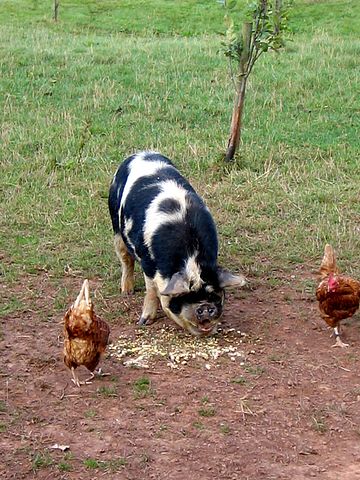鸡和猪的故事
The fable of the Chicken and the Pig is used to illustrate the differing levels of project stakeholders involved in a project. The basic fable runs:[1]
A Pig and a Chicken are walking down the road.
The Chicken says: “Hey Pig, I was thinking we should open a restaurant!”
Pig replies: “Hm, maybe, what would we call it?”
The Chicken responds: “How about ‘ham-n-eggs’?”
The Pig thinks for a moment and says: “No thanks. I’d be committed, but you’d only be involved.”
Sometimes, the story is presented as a riddle:
Question: In a bacon-and-egg breakfast, what’s the difference between the Chicken and the Pig?
Answer: The Chicken is involved, but the Pig is committed!
从这个寓言/冷笑话的故事里我们会有什么启示呢?
- 项目的选择很重要,别人眼里的好项目对你而言可能会让你破产(致命);
- 做事要发挥你的长处和优势(鸡生能蛋);
- 不可再生的资源利用终有枯竭的一天(猪取自身的猪肉);
- 做事要三思而后行考虑得更深远些,如果只考虑很近的利益而不去设想未来就可能会得不偿失.
敏捷管理里面的猪和鸡
Recently,The CEO has hired a external expert to improve products and project development process。 Not long before,the PMs has feedback to me that the expert too aggressive,the PO have almost no effect on the product, Experts say going south, PO dare not go north. And always evaluate the R & D team’s estimated time of mission completely. the expert often said : your products is too rubbish,your project plans are rubbish.
After a while ,the expert left, leaving a group confused people and the rubbish producted by expert.Maybe,it will be a real story…
Scrum严格区分这两类人:对承担项目的人赋予权力,使其完成必要工作,确保项目成功;无责任人员则无权对项目施加不必要的干涉
这两类人在Scrum中被形象地称为“猪”和“鸡”。 “猪”,全力投入项目对项目的输出负责;“鸡”是旁观者,为项目过程提供咨询。在Scrum方法中,上述区分很重要,它关系到Scrum的全面可见性原则。必须时刻区分责任人和出主意的。
pigs, who are totally committed to the project and accountable for its outcome, and chickens, who consult on the project and are informed of its progress. This analogy is based upon the pig being able to provide bacon (a sacrificial offering, for which the pig must die in order to provide) versus a chicken which provides eggs (non-sacrificial).
For a Scrum project the Development Team, Product Owners & Scrum Masters are considered as people who are committed to the project while stakeholders, customers and executive management are considered as involved but not committed to the project.
As of 2011, the fable has been removed from the official Scrum process.[2]
